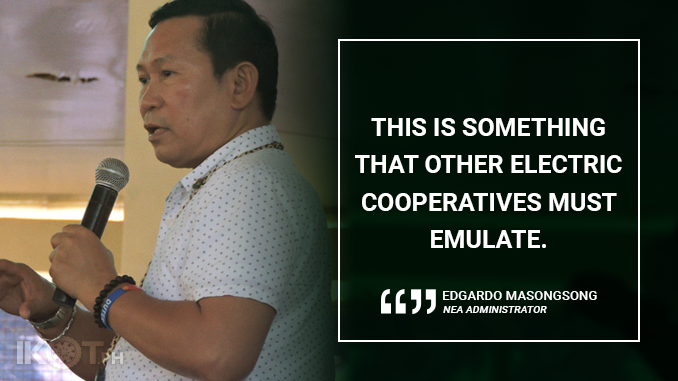National Electrification Administration (NEA) chief Edgardo Masongsong recently led the groundbreaking of a 900-kilowatt (kW) wind turbine power plant in Romblon, Romblon, which is seen to contribute significantly to the growing energy needs of the island.
The wind turbine farm is a joint venture between the Romblon Electric Cooperative, Inc. (ROMELCO) and Japanese firm Komaihaltec, Inc. with assistance from the Ministry of the Environment of Japan. The PhP 242-million project is expected to be completed this November.
In his speech during the groundbreaking ceremony held over the weekend, Masongsong commended ROMELCO, under the leadership of General Manager Rene Fajilagutan and Board of Directors headed by president Diogenes Hilario Magallon, for continuing to lead by example in renewable energy (RE) projects.
The NEA chief described ROMELCO as a “trendsetter” for electric cooperatives in terms of RE development, citing the bold steps the power distribution utility has taken to achieve the target it has ambitiously set for itself.
ROMELCO aims to increase the percentage of its indigenous sources of power from the current 45 percent to 90 percent by 2020.
“It’s a very tall order envisioning a 90 percent source of power from renewables for Romblon. This is actually protecting the environment by minimizing ROMELCO’s carbon footprint at the same time maximizing the benefits from indigenous sources of energy. This is something that electric cooperatives must emulate,” Masongsong said.
This is actually protecting the environment by minimizing ROMELCO’s carbon footprint at the same time maximizing the benefits from indigenous sources of energy.
The project is comprised of three wind turbines located in Barangays Bagacay, Lonos and Agnay in the Municipality of Romblon. Each wind turbine has a power generating capacity of 300 kW, totaling 900 kW.
Masongsong said there are more benefits from the project besides providing a low-cost and reliable electricity and contributing to the energy requirements of the island. This venture also brings environmental and economic benefits to the province, he said.
Romblon Mayor Mariano Mateo agreed, saying that the future looks bright for the province as the wind turbine project will not only address the increasing power consumption of thousands of their residents but it will also attract tourists.
Meanwhile, Fajilagutan said 50 percent of the total cost of the project is funded through a grant from the Ministry of the Environment of Japan while the other half is shouldered by Japanese wind turbine manufacturer, Komaihaltec.
Once up and running, the ROMELCO executive said the wind turbines will be leased to them for four years at PhP 6.19 per kilowatt hour (kWh) without value added taxes.
“It will be based on the actual production, actual output of the wind turbine generator. No fixed amount per month. After four years, the power plant will be turned over to Romelco,” Fajilagutan said.
The wind project is among the many initiatives of ROMELCO aimed at contributing to the sustainable development of the province while helping curb the effects of climate change. Its other RE projects include a two-megawatt (2 MW) biomass power plant and three more units of mini-hydro power plants.
ROMELCO recently acquired a 2.5 MW diesel power plant as initial support to the wind farm. On top of these, it also has 30-kW solar diesel hybrid generation system, which provides 24/7 electricity to some 900 households on Cobrador Island; and 1,350-kW mini hydro power plant in Cantingas, San Fernando, Sibuyan Island.
Masongsong spent his weekend visiting Romblon to keynote the 26th Annual General Membership Assembly of ROMELCO on April 21 held in Magdiwang, Sibuyan Island, which drew some 1,233 member-consumer-owners (MCOs) in attendance.
A triple-A rated EC, ROMELCO is one of the distributors of electricity in the province of Romblon. Included in its franchise are the municipalities of Romblon, San Fernando, Cajidiocan, Magdiwang, Banton, and Corcuera.

